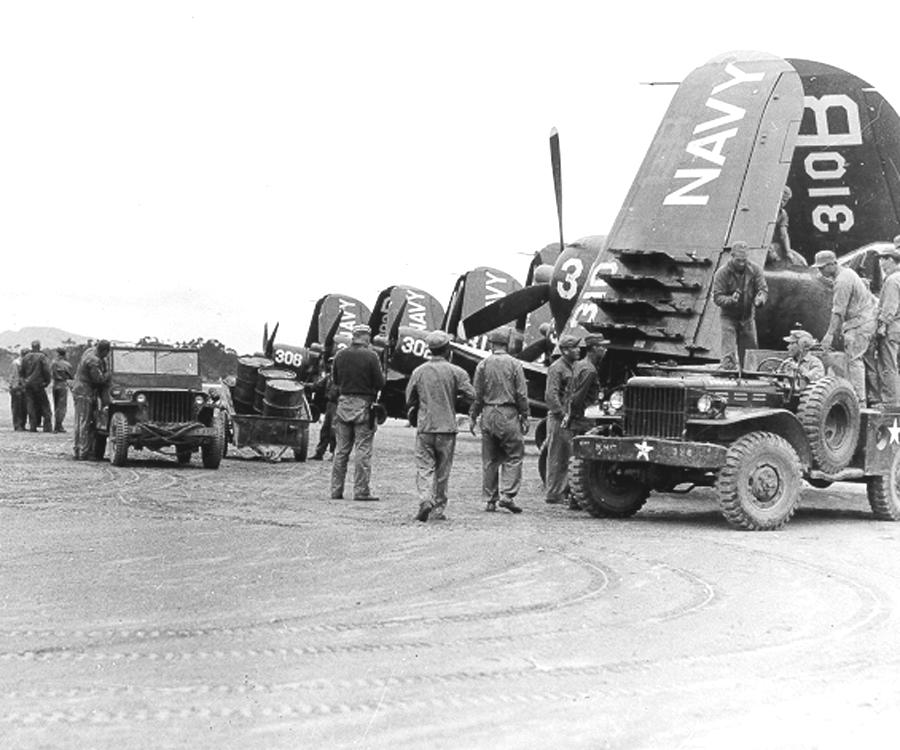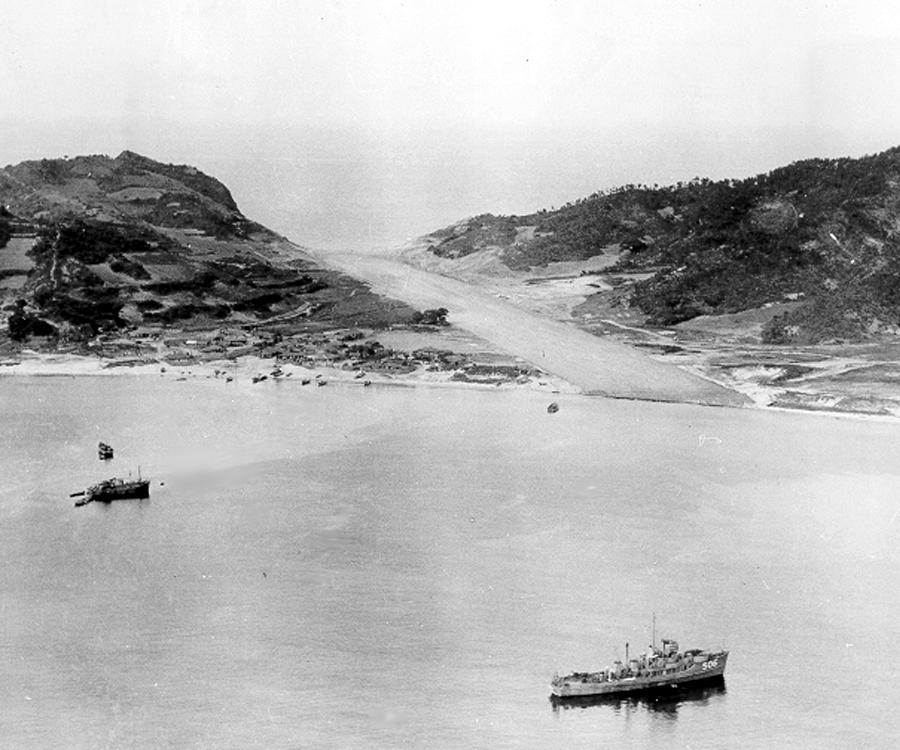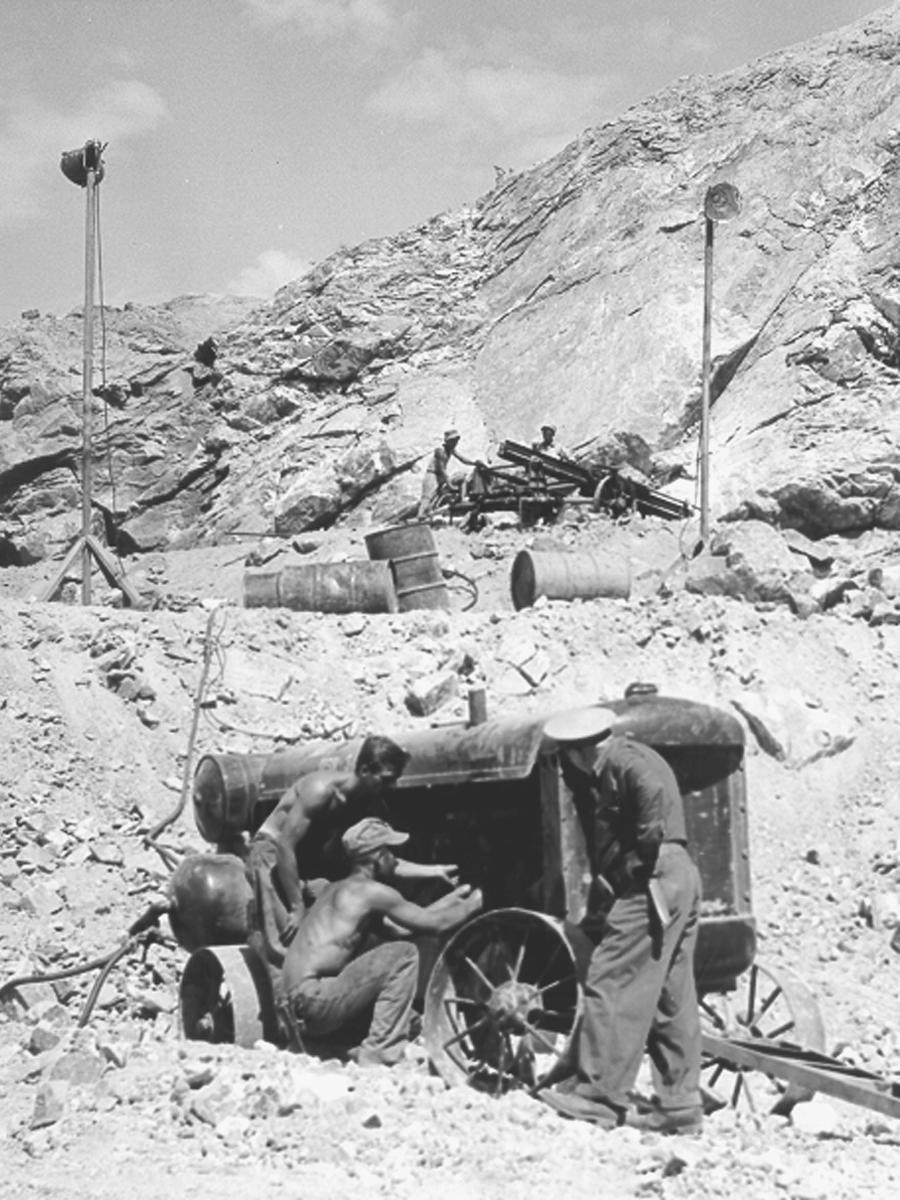|
Seabee Offsite links |
Operation
Crippled Chick By Steve Karoly A flight of seven Vought-Chance F4U-4 Corsairs slowly circles over Wonsan Harbor. Each pilot in turn glances at his fuel gauge. With fuel reserves short, they realize that their only option is to bring the fuel-starved birds down onto the deck and ditch them into the icy waters off Wonsan, North Korea. But this option does not comfort the flight leader or any of his squadron mates. To ditch, they risk injury. And these pilots realize that their squadron, VF 193 from the USS Princeton (CVA 37), would loose half its complement of precious Corsair fighter planes. After a fruitless afternoon searching for a downed naval aviator near Hungnam, the flight leader’s immediate concern is to find sanctuary for his flight. But they had spent too much time searching for their downed comrade. As they flew over the small task group of American destroyers and minesweepers, they knew they would be quickly plucked from the frigid water of the Sea of Japan by waiting boats.
This option, later described as one that pits you "between the Chinese Dragon and the deep blue sea," would not be exercised that afternoon. For soon Radio Yo Do began broadcasting the call "Steak for dinner." Once he heard those comforting words, VF 193’s flight leader instructed his flight to bank their planes toward a 2,400-foot runway in the middle of Wonsan Harbor. The fighters landed at half past two on a rainy afternoon on an Allied-occupied island located some four and a half miles off shore in a harbor belonging to the enemy. Although North Korean gunners could, at any moment, lob hundreds of 76 and 105-mm. shells onto the runway, the pilots knew their chances of survival were greater on the island than in a yellow life raft. A small team of Seabees quickly refueled three of the Corsairs so they could return to the Princeton that evening. The remaining four were refueled in the morning before taking off for the aircraft carrier. The Corsairs and their pilots flew off so they could return to battle again. This was a day of jubilation for the Seabees. They had worked 19 long days to complete the emergency landing strip, dubbed Briscoe Field in honor of the commander of the 7th Fleet. The seven Corsairs of VF 193 were the first planes to make an emergency landing on the strip. How the airfield came to be The assignment to build the emergency landing strip on Yo Do fell to ACB 1’s Det. George. Led by Lt. T.E. Rowe, Det. George was composed of one warrant machinist, six chief petty officers and 69 Seabee enlisted men. Six of these Seabees proudly wore the blue, yellow and red ribbon for the Presidential Unit Citation, which was awarded to ACB 1 for the landing at Inchon almost two years earlier. A month after the September 15, 1950 landing at Inchon, ACB 1 moved to the east coast of Korea and again supported the 1st Marine Division. This time they landed at the port city of Wonsan as part of the 1st Marine Division’s shift from the Inchon-Seoul area to the northeast coast of Korea. While the Marines moved north to positions in the Chosin Reservoir area, the Seabees built piers and unloaded ships. Later that month, as elements of the 8th Army reached the Yalu River, the tide turned for the Allies when the Chinese Communist Army struck the 8th Army in late November. The 1st Marine Division came under attack on November 27, 1950. For the next three weeks, the Marines made their famous "advance to the rear" as they evacuated Chosin Reservoir. The 8th Army lost all the territory they had gained as they fell back. Inchon and Wonsan were evacuated and Seoul fell on January 4, 1951. By the end of November, all Seabees but one had evacuated Wonsan. This time Wonsan would remain in enemy hands for the rest of the war. To keep the Communists from using Wonsan, Navy Task Force 77 stepped its air interdiction efforts in the spring and summer of 1951. In the sixteen months since the evacuation of Wonsan and Hungnam, the Navy waged a campaign of destruction along the northeast coast of North Korea. Almost daily, pilots struck key transportation and supply points. But by the spring of 1952, the Navy recognized a problem. Scores of aircraft had been lost to the antiaircraft guns around Wonsan. One ship, the converted helicopter landing ship USS LST 799, had plucked 24 Allied aviators from the Sea of Japan. Most of these aviators were rescued in the vicinity of Wonsan. Destroyers waiting in the bay picked up many more aviators. These pilots had a choice: They could crash land in North Korea and face capture by the Communists or ditch their craft in the icy waters alongside an Allied ship. If a ship’s boat crew or rescue helicopter reached the pilot before hypothermia set in, he had a chance of survival. Although the plane was lost to the Sea of Japan, the pilot lived to fly again. But Lt. Col. Richard G. Warga, commander of the US Marine garrison on Yo Do Island in 1951, had a better idea. After interviewing several pilots who had ditched in the bay in the summer of 1951, Warga and his naval liaison, Lt. James S. Lampe, Jr., reasoned that the approaching winter would make survival difficult. So they recommended that the Navy build an emergency airfield on the island. Seabees build an airfield The 7th Fleet commander, Vice Adm. Robert P. Briscoe, carefully weighed all the factors involved. A 1953 Navy press release characterized this analysis much like an accountant gazes at a balance sheet. While there were concerns for how the North Koreans would react to construction of an airfield, Briscoe felt that salvage of a single plane was worth the effort. In the end, it cost the Navy $5 milllion to save nearly $10 million in aircraft.
The balance sheet would not be complete unless you consider the human factor. Dozens of pilots were saved from capture and possible death at the hands of the Communists. Damaged planes landed on dry land, thus keeping them out of the frigid waters off Wonsan. The remaining factor cannot be measured, which can be called the "comfort factor." As pilots circled over their targets, they knew that all they had to do was fly a few miles to safety if their aircraft was crippled by antiaircraft fire or ran low on fuel. On June 6, 1952, the Seabees initiated Operation Crippled Chick, the code name for the effort to build the emergency airstrip on Yo Do. Det. George, which was assembled for the job because all available mobile construction battalions were tied up building the airfield at Cubi Point in the Philippines, sailed on the USS LST 692 from Japan on June 3. The first obstacle that confronted the Seabees was how to beach the pontoon causeway on a beach that had a very shallow gradient. Officers on the beach were concerned that the Seabees would not get causeway high enough onto the beach to anchor it properly. But the Seabees had an answer: After they dropped the causeway sections into the water and had connected them together, these resourceful Seabees pushed the causeway onto the beach with the bow of the LST. An officer on the scene later commented that the Seabees off loaded their equipment in "jig time." The plan was for Det. George to have a 120-foot by 2,400-foot airfield operational in 45 days. Nineteen days later, on June 27, Det. George boarded an LST and returned to Japan, their mission complete.
They filled in and leveled the only rice paddies on the island, the only possible location for an airstrip. The runway ran from one side of the island to the other, bisecting the island. For the first 12 days ashore, the Seabees worked 16-hour days. On June 15, two days after receiving their first of two shellings from North Korean batteries on the mainland, the officer-in-charge reported that the runway was 50 percent complete. At that point it was 80-feet wide and 1,600-feet long. Eventually, the runway was widened to 200-feet. Det. George twice received shellfire from the North Koreans. On June 13, 21 rounds fell between 2015 and 2030. All it did was interrupt the Seabees’ work day. Det. George worked an extra hour to compensate. The log of the detachment again reported shellfire on June 21. This time 41 155-mm. rounds fell among the small boats kept on the island. There were no Seabee casualties. Maintenance crew stays behind With the emergency airfield completed, a small Seabee detachment under command of Chief Mechanic Eugene T. Weatherford remained on the island for an additional three weeks. Weatherford and the 10 Seabees under his charge stayed on the island as a "maintenance and salvage detail," according to the final report of the group, known as Det. George Able. The main task of the Det. George Able appears to have been the removal of "as much of the rock as possible from the northeast end of the airstrip." Although the detachment spent much of their time repairing the runway surface and filling in the low spots, a three-page log that accompanied the final report emphasized these earthmoving duties. "Work was continued on removing rocky barrier at NE end of the strip by blasting with TNT and dozing off of spoil," the report continues. The log states that "187-feet of width is available at that point which is only 13-feet narrower than all the rest of the runway." It took them until July 14 to remove most of the ridge. Det. George Able worked until they used the last of the TNT. Weatherford reported on July 11: "In this rock it takes about four hours to drill a hole 18 inches deep in order for us to do any blasting. The going is slow." The next day, he reported that they had enough TNT to "make one more shot." After reducing the ridge to 35 percent of it original height, Weatherford said the drivers would continue to use their D7 Caterpillar bulldozer to further reduce the height of the ridge. The ridge did not seem to impede air traffic. The log reported that the detachment watched a plane, which landed on July 10, use only three-fourths of the strip. The plane, a C47, cleared the field at the 1,200-foot mark when it took off. Weatherford reported that the runway "was plenty solid to support" the plane. Again, Det. George Able watched C47s land on the 12th, 13th and 14th. Then on July 15, 1952, the flight of seven Corsairs made the first emergency landing on the Yo Do airfield. On the 16th, the Seabees started refueling the four Corsairs that stayed overnight. After they flew off to the Princeton, Det. George Able spent the remainder of the day hauling aviation gas and oil from the beach to the fuel dump, which was located by the runway. The detachment departed Yo Do Island on the USS Comstock (LSD 19) at noon on July 17, 1952. They were not the last Seabees to see Yo Do. A small detachment from CBMU 101 deployed to act as public works for the island. They remained until August 1953 when the truce was signed. As part of the agreement that ended hostilities, the Allies were required to return Yo Do to North Korean control. But before going home, they removed all valuable equipment and destroyed what they could not take with them. This story is found in No. 5 (Winter 1999) of the Seabee Log.
|
|||||||||||||||




